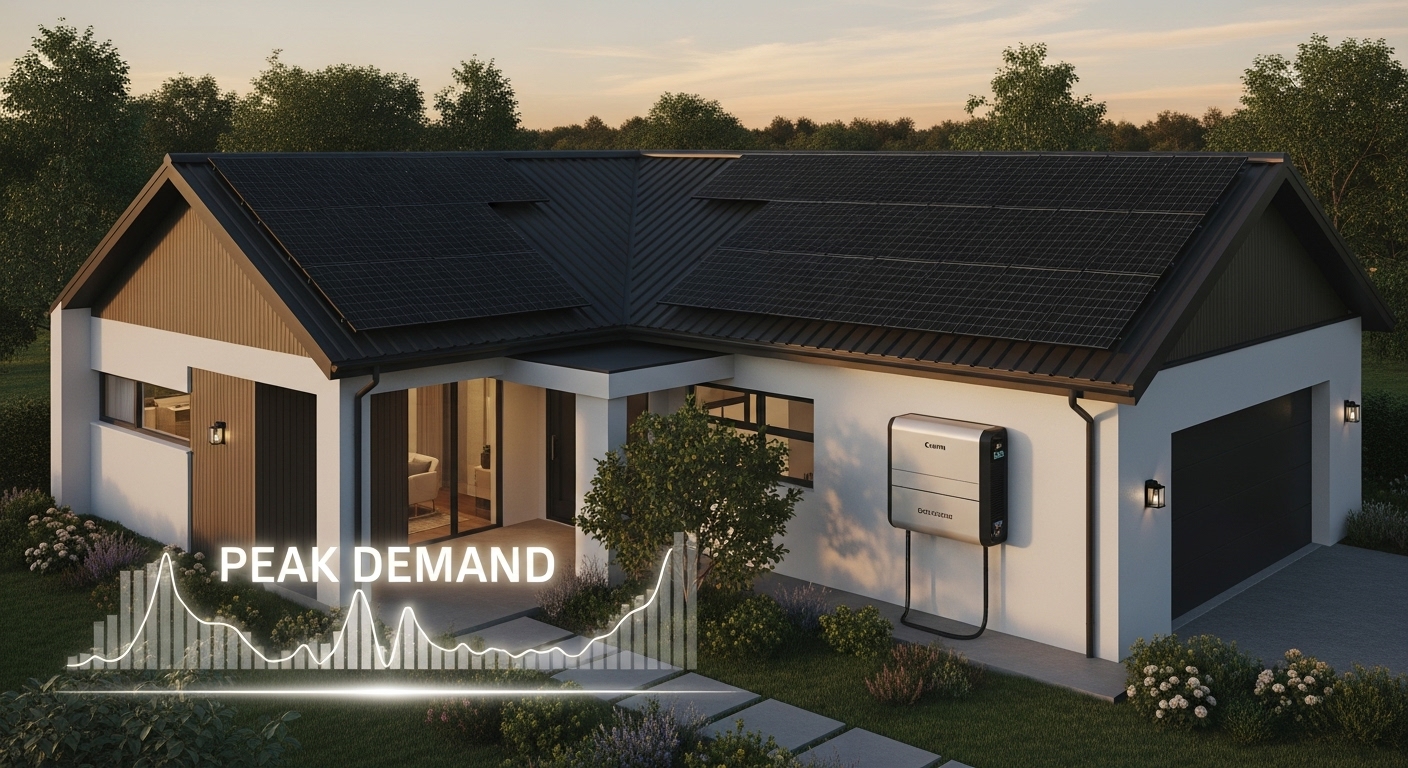Article
Understanding Peak Demand Charges and How Solar Can Help Reduce Them

Historically, residential utility bills were based entirely on volumetric electric rates, meaning that you only paid for the total amount of energy used each month. But utility companies are increasingly applying peak demand charges to residential customers. What does this mean for you, and how can solar support effective demand reduction? Join us for a guide to peak demand charges and what you can do to lower utility demand fees with solar energy.
Understanding Peak Demand Charges
To better understand how solar energy can encourage a reduction in demand charges, it’s important to have a solid grasp on what these fees are, how they’re calculated, and how they can affect your monthly utility bills.
What are Peak Demand Charges?
While volumetric electric rates are still the norm for residential utilities in the US, there’s a growing push to add peak demand charges to the average homeowner’s monthly bill. These are fees that reflect the strain a household places on the grid during its most energy-intensive times. Many utility companies monitor energy usage in 15- to 30-minute periods and use the largest demand period to determine the billing cycle’s peak demand charge.
These fees are said to account for the infrastructure needed to ensure every home and business has access to the electricity they need whenever they need it. According to industry insiders, the goal is to encourage more mindful energy consumption across the board.
Each utility company sets its own rates, but most calculate the charge by multiplying the highest average usage in kilowatts (kW) by the established demand charge rate. If your highest usage period is 9 kW and the rate is $4 per kW, you will pay an additional $36 at the end of that billing period.
The Impact of Peak Demand Charges on Your Electricity Bill
In the past, peak demand charges were only a problem for commercial entities like factories and product manufacturers who may run multiple air conditioners and heavy equipment that can simultaneously draw excessive power. However, that’s no longer the case. These days, more and more utility providers are adding demand fees to residential agreements.
Let’s say you take care of a substantial portion of your chores on Saturday mornings when you have a little extra free time. By running your washing machine, dryer, dishwasher, and vacuum cleaner in the same 15 to 30-minute interval, your utility company assumes that you may require that volume of energy at any given time and adjusts your peak demand charge to reflect that need, even if you only place such a demand on your system once throughout the billing period.
How Solar Energy Can Help Reduce Peak Demand Costs
Solar is a powerful tool against peak demand charges, helping you achieve greater energy independence and lower excessive utility demand fees. Here’s how:
Generating Your Own Electricity During Peak Times
In an ideal world, you would have plenty of time to spread out your energy needs throughout the day and the billing cycle. However, most of us lead busy lives and must multitask to cross everything off our to-do list. Instead of restructuring your life to ensure steady energy usage, what if you generated clean, renewable energy to meet your needs?
A well-designed solar array produces on-site electricity to offset your grid-sourced energy consumption, especially during sunlight hours when energy demand is often at its peak. As your system generates solar energy, you can drastically reduce the amount of power you require from the grid, taking strain off your utility company’s infrastructure and facilitating lower utility demand fees.
Optimize Energy Savings With Battery Storage
When the sun isn’t shining, your solar panels won’t have access to the energy they need to operate. Fortunately, the right solar battery can bridge the gap. Many residential arrays produce more energy than needed during the day. If your utility company offers net metering, you may be able to sell this surplus energy back to the grid in exchange for credits on future electricity consumption. However, those without that luxury will lose any extra power without solar battery storage.
Solar batteries allow you to store excess energy for use at night or during stormy weather when power needs are still high. They can typically be programmed to discharge at times when your energy needs increase, leading to lower peaks, more predictable utility bills, and greater protection against unexpected demand spikes. In fact, they may be the most important tool for optimizing your solar array, helping you maximize potential savings.
Tailored Solar Solutions for Peak Demand Management
No two households are identical, so effectively reducing your energy demand with solar requires professional insights. While it may be tempting to opt for a pre-fabricated kit you order online, a one-size-fits-all solution won’t meet your home’s unique needs. To lower utility demand fees, a custom-designed solar panel array is key. Here’s how personalized solar systems can support demand reduction:
- Home energy audit: Assesses your home’s efficiency, consumption patterns, and overall demand to create a comprehensive profile of your property and energy needs.
- Fully personalized: A site assessment will help determine the best system, size, and positioning for your array based on your roof’s layout and orientation.
- Live monitoring: Built-in software allows for immediate insights into solar panel performance and energy consumption to better optimize your array.
- Smart energy management: Integrate programmable thermostats, plugs, and appliances with your array to automate load control, respond to changes in demand, and strategically manage battery charges for enhanced efficiency.
In some cases, it may be possible to integrate smart home solutions and live monitoring programs with a pre-fab solar array, but you won’t have the help of an experienced solar specialist to guide you through the process and ensure optimal performance and efficiency.
Understanding Your Electricity Bill
Residential utility bills generally consist of two primary components: volumetric energy charges and peak demand charges. Volumetric charges, sometimes referred to as energy charges or consumption charges, are what most people think of when they pay for electricity. These quantify the total amount of energy you use throughout the billing cycle and are typically measured in kilowatt-hours (kWh).
Not all utility providers bill for peak demand charges, but those that do may list them as demand charges, peak demand, or kW demand on your bill. They may be itemized in their own section or included under “delivery charges.” Demand rates should be measured in kilowatts (kW) instead of kilowatt-hours (kWh).
Practical Guidance for Homeowners
Ready to learn to effectively implement solar solutions to lower utility demand fees? Here’s a step-by-step guide to achieving demand reduction with solar:
- Analyze Energy Usage: Hire a certified energy auditor to identify inefficiencies in your home and suggest solutions to improve them.
- Improve Your Home’s Efficiency: Based on the auditor’s findings, make the recommended upgrades to your appliances, insulation, and weather-proofing to ensure optimal efficiency before purchasing a solar array.
- Professional Solar Assessment: A personalized solar assessment will help determine the right array for your needs.
- Compare Multiple Proposals: Reach out to several highly-rated solar companies to compare options and financing offers.
- Implement Smart Energy Tools: Once your array is installed, maximize efficiency with smart home tools that will simplify your life.
- Apply for Incentives and Permits: Federal, state, and local tax incentives and rebates can drastically lower your upfront costs. The right solar installer can help you apply for these incentives and any necessary permits to operate your array.
- Monitor and Maintain: Perform routine maintenance and monitor performance and energy usage through your built-in monitoring system to ensure long-term efficiency.
Long-Term Benefits of Solar Energy
What are the long-term financial and environmental benefits of achieving demand reduction through solar energy? In addition to one-time rebates and tax incentives, you may also enjoy:
- Lower utility bills and demand fees
- Protection against rising electrical rates
- Increased property value
- Property tax exemptions
- Access to clean, renewable energy
- Reduced carbon footprint
- Greater energy independence
Achieve Financial Stability Through Solar Investment
Understanding peak demand charges – and how solar solutions can lead to demand reduction – is a critical step to achieving optimal long-term savings and a faster return on your investment. When you’re ready to take proactive steps towards energy management, Solar Energy World will be here to help. Get started with a free solar estimate!
Want a Free Solar Estimate?
Fill out the form to get started today.


